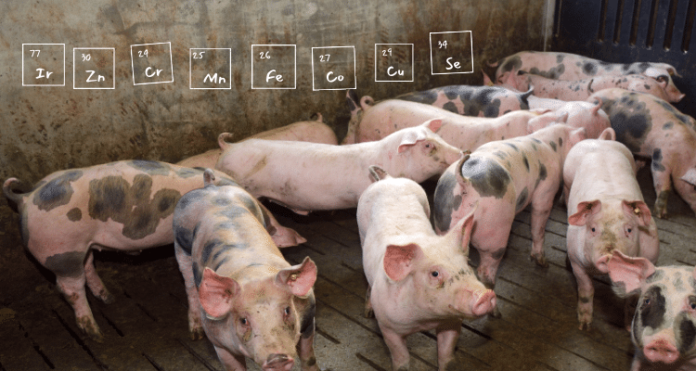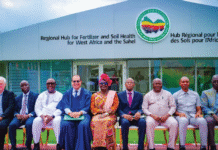Did you ever wonder about the trace mineral levels in pig feed your neighbour is using compared to you? Well researchers surveyed animal feed companies in the Brazilian pork sector to find out the actual levels of trace minerals used in commercial pig diets in different regions of Brazil compared to recommendations and what is used in North American commercial diets. Here is a summary of some of the findings that might give you a few pointers if you are looking for benchmarks amongst your peers.
Are reference tables for trace mineral levels in pig feed outdated?
Nutritional requirements for most trace minerals in pigs were determined with a focus on avoiding nutritional deficiencies and go as far back as the 1990s. They are based on minimum requirement levels of supplementation (NRC 2012, US) or values to optimize cost/benefit in feed formulations (Rostagno 2017, Brazil). However, there is evidence that commercial pig diets quite often contain nutrient levels that are greater than the recommended levels. This practice seems to partly originate from the belief that productivity can be improved by increased supplementation or the fear of not meeting requirements otherwise. However, between pig farms there is a great deal of variation when it comes to the supplementation of trace mineral levels in pig feed, which can also be due to differences in pig genetics used, feed composition, management objectives or differing opinions on requirements.
What level of trace minerals is my neighbour feeding in pig diets?
In a 2020 survey (Dalto and da Silva 2020) involving 30 feed companies and co-operatives of the Brazilian pork industry the levels of trace minerals in commercial pig diets were identified and compared against the Brazilian reference tables as well as those from the North American industry. The results showed that Brazilian companies added significant safety margins for trace minerals to commercial pig diets and the supplementation levels were higher compared to those reported in a 2016 survey carried out in the North American pig industry. More details are summarized below.
Trace mineral levels in pig feed reported on farms in Brazil
Nursery diets (21-70 days):
Trace minerals levels were 0.9- to 15.3-fold the respective levels from Brazilian recommendations and 0.5- to 2.2-fold those from those found in a survey of US commercial nursery diets.
Means reported in Brazilian nursery diets (21-35 days):
– Copper (mg/kg): 141.4
– Zinc (mg/kg): 1876.1
Grow-finishing diets (71 days to slaughter):
The highest variation seen in trace mineral levels was for Cu, Mn and Co between companies and Manganese and Iodine levels were markedly higher compared to US commercial finisher diets.
Means reported in Brazilian commercial finisher diets for Cu, Co and Mn (120 days to slaughter):
– Copper (mg/kg): 85.8
– Cobalt (mg/kg): 0.44
– Manganese (mg/kg): 35.8
Lactation diets:
The trace mineral levels in sow lactation diets were 1.0 to 12.4 times higher compared to Brazil reference tables and higher compared to what was reported in US commercial sow lactation diets. Trace minerals that were found to be markedly higher were, Cu, I, Mn. The trace minerals with the highest variation between companies were Cu and Co.
Means reported in Brazilian commercial sow lactation diets for Cu, I and Mn:
– Copper (mg/kg): 54.1
– Iodine (mg/kg): 0.98
– Manganese (mg/kg): 49.6
More details on the levels of trace element levels in Brazilian pig diets are reported in:
Dalto and da Silva (2020). A survey of current levels of trace minerals and vitamins used in commercial diets by the Brazilian pork industry—a comparative study. Translational Animal Science, Vol 4.
Trace mineral levels in feed reported on pig farms in the US
A 2016 survey (Flohr et al 2016) involving 18 swine nutritionists from US pig producers representing 40% of the US sow herd revealed that adding a margin of safety in trace minerals supplementation above the estimations for requirements by NRC (2012) is standard practice in many US pig diet formulations. The variation seen between pig producers was quite high and was thought to reflect the differences in opinions regarding requirements and productivity goals.
Chelated trace mineral supplementation was mainly practiced in early nursery and breeding herd diets, whereby chelated selenium was the most frequently used of all the chelated trace minerals (up to 69% of producers used chelated selenium in early nursery diets and up to 77% in breeding herd diets).
Trace mineral levels found in commercial US nursery diets:
Weaning to 7kg: Whereby Iron and selenium were supplemented according to recommendations (NRC 2012), copper and zinc were supplemented well above the requirement estimate at 18.6 and 30.3 times higher, respectively.
Mean levels found for zinc and copper
– Copper (mg/kg): 111.1
– Zinc (mg/kg): 3032
7 to 11kg: Trace minerals were supplemented at rates of 1.0 (selenium) to 9.1 times their NRC requirement estimates, except for zinc (20.8) and copper (19.7).
Mean levels found for zinc and copper
– Copper (mg/kg): 118.2
– Zinc (mg/kg): 2081
Trace mineral levels found in commercial US finishing diets (55-100kg):
There was a high variability seen in copper levels and copper as well as manganese supplementation was particularly high compared to NRC recommendations.
Average levels found for copper and manganese:
– Copper (mg/kg): 82.3
– Manganese (mg/kg): 21.4
Trace mineral levels found in commercial US sow lactation diets:
Trace-mineral supplementation in sow lactation diets was 0.8 to 3.8 times higher compared to NRC recommendations.
Average levels found for copper, iodine and manganese:
– Copper (mg/kg): 16.1
– Iodine (mg/kg): 0.53
– Manganese (mg/kg): 37.6
More details on the levels of trace element levels in commercial US pig diets are reported in:
Flohr et al (2016). A survey of current feeding regimens for vitamins and trace minerals in the US swine industry. J Swine Health Prod. Vol. 24(6).
Need for precision in trace mineral feeding for pig production
In modern pig production trace mineral levels in pig feed are not just important in terms of meeting requirements for productivity and animal welfare, but also in terms of meeting environmental concerns.
When trace elements are supplemented in doses above the gross requirement, they accumulate in urine and faeces and consequently in manure. This is why a low precision in trace element feeding in livestock production can represent a potential threat to the environment.
The need to reduce heavy metal emissions from animal production to minimize the impact on the environment, calls for increased precision of trace element feeding. This requires accurate feed table information on trace element digestibility under varying feeding conditions.
Furthermore, feedstuffs contain innate levels of trace minerals, which are often ignored in feed formulations. However, since the use of feed enzymes and modern feed processing methods can increase the availability of innate trace minerals, their contribution to overall trace element levels in pig feed should be considered.
Supplementation with more bioavailable organic trace minerals such as B-TRAXIM allow a reduction of up to 50% of dietary trace element supplementation versus supplementation of trace minerals in their inorganic form while maintaining performance. Therefore. organic trace elements can be a cost-effective tool when it comes to precision livestock feeding and reducing the environmental footprint of pig farms.
Find out more about the Pancosma organic trace mineral portfolio B-TRAXIM here.
References and related articles
Dalto and da Silva (2020). A survey of current levels of trace minerals and vitamins used in commercial diets by the Brazilian pork industry—a comparative study. Translational Animal Science, Vol 4.
Flohr et al (2016). A survey of current feeding regimens for vitamins and trace minerals in the US swine industry. J Swine Health Prod. Vol. 24 (6).
Zoon and Robin (2021). How to improve animal production sustainability with organic trace – minerals.
Video: Interview with Christian Bogues about B-TRAXIM minerals









